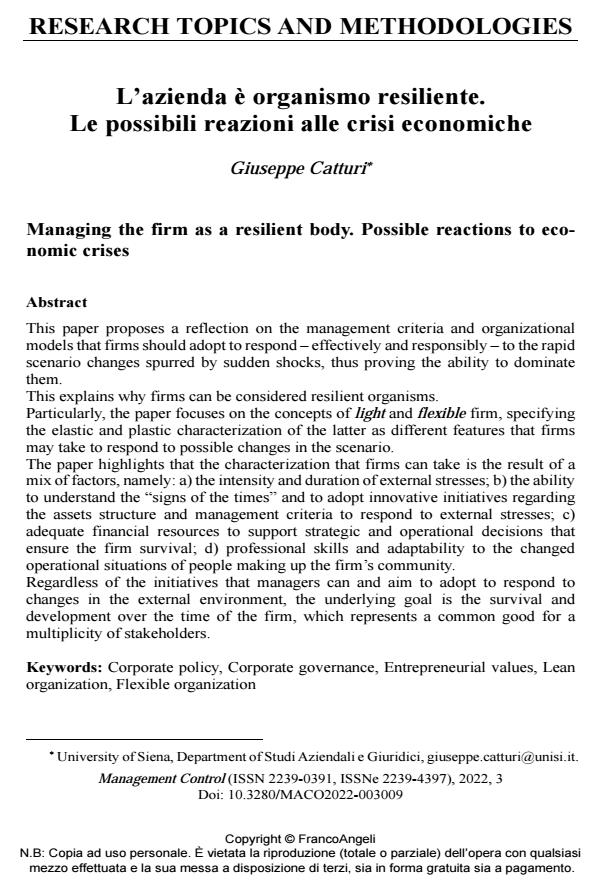Managing the firm as a resilient body. Possible reactions to economic crises
Journal title MANAGEMENT CONTROL
Author/s Giuseppe Catturi
Publishing Year 2022 Issue 2022/3
Language Italian Pages 26 P. 177-202 File size 275 KB
DOI 10.3280/MACO2022-003009
DOI is like a bar code for intellectual property: to have more infomation
click here
Below, you can see the article first page
If you want to buy this article in PDF format, you can do it, following the instructions to buy download credits

FrancoAngeli is member of Publishers International Linking Association, Inc (PILA), a not-for-profit association which run the CrossRef service enabling links to and from online scholarly content.
This paper proposes a reflection on the management criteria and organizational models that firms should adopt to respond - effectively and responsibly - to the rapid scenario changes spurred by sudden shocks, thus proving the ability to dominate them. This explains why firms can be considered resilient organisms. Particularly, the paper focuses on the concepts of light and flexible firm, specifying the elastic and plastic characterization of the latter as different features that firms may take to respond to possible changes in the scenario. The paper highlights that the characterization that firms can take is the result of a mix of factors, namely: a) the intensity and duration of external stresses; b) the ability to understand the "signs of the times" and to adopt innovative initiatives regarding the assets structure and management criteria to respond to external stresses; c) adequate financial resources to support strategic and operational decisions that ensure the firm survival; d) professional skills and adaptability to the changed operational situations of people making up the firm’s community. Regardless of the initiatives that managers can and aim to adopt to respond to changes in the external environment, the underlying goal is the survival and development over the time of the firm, which represents a common good for a multiplicity of stakeholders.
Keywords: Corporate policy, Corporate governance, Entrepreneurial values, Lean organization, Flexible organization
- Catturi G. (1971), L’impresa come organismo tridimensionale e i suoi obiettivi alternativi al profitto, Rivista dei dottori commercialisti, 6.
- Bianchi C., Vignieri V. (2020), Dealing with “abnormal” business growth by leveraging local area common goods: an outside-in stakeholder collaboration perspective, International Journal of Productivity and Performance Management, 70(3), pp. 613-634.
- Cabri G., Fioretti G. (2022), Flexibility out of standardization, International Journal of Organization Theory & Behavior, 25, 1/2, pp. 22-38.
- Catturi G. (2021), Potere aziendale, pandemia e smart working, Management Control, Suppl. 2, pp. 15-38. DOI: 10.3280/MACO2021-002-S1002
- Catturi G., Ricci Paulesu L. (2020), L’azienda “organismo intelligente”: il fenomeno dell’omeostasi ed i sistemi di controllo, Management Control, 2, pp. 11-36. DOI: 10.3280/MACO2020-002002
- Ceccherelli A. (1961), Economia aziendale e Amministrazione delle imprese, Firenze, Editrice Universitaria.
- Coda V. (2010), Entrepreneurial Values and Strategic Management: Essays in Management Theory, New York, Palgrave Macmillan.
- Colchado O. C. (2013), La Atribuciòn causal y las emociones negativas (Depreciòn), Grin Verlag.
- Cupertino S., Consolandi C., Vercelli A. (2019). Corporate social performance, financialization, and real investment in US manufacturing firms, Sustainability, 11(7), 1836.
- Ferri P. (2002), La macroeconomia di breve periodo, Torino, Giappichelli.
- Ferri P. (2011), Macroeconomics of growth cycles and financial instability, Cheltenham, Elgar.
- Goodwin R.M. (1982), Essays in Economic Dynamics, London, Macmillan.
- Krafcik J.F. (1988), Triumph of the lean production system, MIT Sloan Management Review, 30(1), 41.
- Kydland, F. E., Prescott, E. C. (1982), Time to Build and Aggregate Fluctuations, Econome-trica, 50, pp. 1345-1370.
- Kydland, F. E. and Prescott, E. C. (1990), Business Cycles: Real Facts and a Monetary Myth, Federal Reserve Bank of Minneapolis Quarterly Review, 14, pp. 3-18.
- Maturana H., Varela F. (1980), L’albero della conoscenza, Garzanti.
- Ponzanelli G. (1977), Lezioni di Ragioneria Generale, Siena, Tipografia Ticci.
- Riparbelli A. (1962), Correlazioni ed interdipendenze fra organismi aziendali, Pisa, Cursi.
- Sapir E. (1972), Cultura, linguaggio, personalità, Torino, Einaudi.
- Welter F. (2011), Contextualizing Entrepreneurship – Conceptual Challenges and Ways Forward, Entrepreneurship Theory and Practice, 35(1), pp. 165-184.
Giuseppe Catturi, L’azienda è organismo resiliente. Le possibili reazioni alle crisi economiche in "MANAGEMENT CONTROL" 3/2022, pp 177-202, DOI: 10.3280/MACO2022-003009